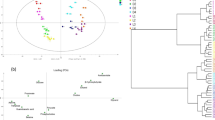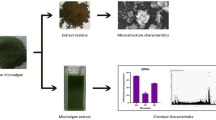Abstract
Echinacea angustifolia cell suspension cultures are usually grown and maintained in the dark, but we also exposed cells to light for one culture cycle (14 days) and then compared the metabolomes of dark-grown and illuminated cells by liquid chromatography–mass spectrometry. Among 256 signals, we putatively identified 159 molecules corresponding to 56 different metabolites plus their fragments, adducts and isotopologs. The E. angustifolia metabolome consisted mainly of caffeic acid derivatives, comprising (a) caffeic acid conjugated with tartaric, quinic and hexaric acids; and (b) caffeic acid conjugated with hydroxytyrosol glycosides (e.g., echinacoside, verbascoside and related molecules). Many of these metabolites have not been previously described in E. angustifolia, which currently lacks detailed metabolic profiles. Exposure to light significantly increased the levels of certain caffeic acid derivatives (particularly caffeoylquinic acids and hydroxytyrosol derivatives lacking rhamnose residues) and reduced the level of hydroxytyrosol derivatives with rhamnose residues, revealing that light specifically inhibits the rhamnosylation of caffeoyl phenylethanoid glycosides. These results are significant because they suggest that the metabolic profile of cell cultures can be manipulated by controlling simple environmental variables such as illumination to modulate the levels of potentially therapeutic compounds.


Similar content being viewed by others
Abbreviations
- HPLC–DAD:
-
High performance liquid chromatography–diode array detector
- HPLC–MS:
-
High performance liquid chromatography–mass spectrometry
- m/z :
-
Mass to charge ratio
References
Abbasi BH, Tian CL, Murch SJ, Saxena PK, Liu CZ (2007) Light-enhanced caffeic acid derivatives biosynthesis in hairy root cultures of Echinacea purpurea. Plant Cell Rep 26:1367–1372
Barnes PM, Powell-Griner E, McFann K, Nahin RL (2004) Complementary, alternative medicine use among adults: United States, 2002. Advance data from vital and health statistics; number 343. National Center for Health Statistics, Hyattsville
Bauer R (1998) Echinacea: biological effects and active principles. In: Lawson LD, Bauer R (eds) Phytomedicines of Europe. Chemistry and biological activity. ACS, Washington, pp 140–157
Bauer R (2000) Chemistry, pharmacology and clinical applications of Echinacea products. In: Mazza G, Oomah B (eds) Herbs, botanicals, and teas. Functional foods and nutraceuticals series, 2nd edn edn. Technomic Publishing Co, Lancaster, pp 45–74
Bauer R, Remiger P, Wahner H (1989) Alkamides from the roots of Echinacea angustifolia. Phytochemistry 28:505–508
Binns ES, Arnason JT, Baum BR (2002) Phytochemical variation within populations of Echinacea angustifolia (Asteraceae). Biochem Syst Ecol 30:837–854
Bodinet C, Buescher N (1991) Antiviral and immunological activity of glycoproteins from Echinacea purpurea radix. Planta Med 57(Suppl2):A33–A34
Castro J, Krishna MVB, Choiniere JR, Marcus RK (2010) Analysis of caffeic acid derivatives in Echinacea extracts by liquid chromatography particle beam mass spectrometry (LC–PB/MS) employing electron impact and glow discharge ionization sources. Anal Bioanal Chem 397:1259–1271
Cheminat A, Zawatzky R, Becker H, Brouillard R (1988) Caffeoyl conjugates from Echinacea species: structure and biological activity. Phytochemistry 27:2787–2794
Dal Toso R, Melandri F (2011) Echinacea angustifolia cell culture extract. Added value for sport and fitness. Nutrafoods 10(4):19–25
Fiehn O, Sumner LW, Rhee SY, Ward J, Dickerson J, Lange BM, Lane G, Roessner U, Last R, Nikolau B (2007) Minimum reporting standards for plant biology context information in metabolomics studies. Metabolomics 3:195–201
Gamborg OL, Miller RA, Ojima K (1968) Nutrient requirements of suspension cultures of soybean root cells. Exp Cell Res 50:151–158
Hemm MR, Rider SD, Ogas J, Murry DJ, Chapple C (2004) Light induces phenylpropanoid metabolism in Arabidopsis roots. Plant J 38:765–778
Lloyd JU (1924) A Treatise on Echinacea. In: Drug Treatise No 30. Lloyd Brothers, 446 Pharmacists Inc., Cincinnati Ohio
Lucchesini M, Bertoli A, Mensuali-Sodi A, Pistelli L (2009) Establishment of in vitro tissue cultures from Echinacea angustifolia D.C. adult plants for the production of phytochemical compounds. Sci Hortic 122:484–490
Luettig B, Steinmuller C, Gifford GE, Wagner H, Lohmann-Matthes ML (1989) Macrophage activation by the polysaccharide arabinogalactan isolated from plant cell cultures of Echinacea purpurea. J Natl Cancer Inst 81:669–675
Maas M, Petereit F, Hensel A (2009) Caffeic acid derivatives from Eupatorium perfoliatum L. Molecules 14:36–45
Matsuda F, Hirai YM, Sasaki E, Akiyama K, Yonekura-Sakakibara K, Provart NJ, Sakurai T, Shimada Y, Saito K (2010) AtMetExpress development: a phytochemical atlas of Arabidopsis development. Plant Physiol 152:566–578
McDougall B, King PJ, Wu BW, Hostomsky Z, Reinecke MG, Robinson WE Jr (1998) Dicaffeoylquinic and dicaffeoyltartaric acids are selective inhibitors of human immunodeficiency virus type 1 integrase. Antimicrob Agents Chemother 42:140–146
Molgaard P, Ravn E (1988) Evolutionary aspects of caffeoyl ester distribution in dicotyledons. Phytochemistry 27:2411–2421
Mudge E, Lopes-Lutz D, Brown P, Schieber A (2011) Analysis of alkylamides in Echinacea plant materials and dietary supplements by ultrafast liquid chromatography with diode array and mass spectrometry detection. J Agric Food Chem 59:8086–8094
Muller-Jakic B, Breu W, Probstle A, Redl K, Greger H, Bauer R (1994) In vitro inhibition of cyclooxygenase and 5-lipoxygenase by alkamides from Echinacea and Achillea species. Planta Med 60:37–40
Roesler J, Emmendorffer A, Steinmuller C, Luettig B, Wagner H, Lohmann-Matthes ML (1991) Application of purified polysaccharides from cell cultures of the plant Echinacea purpurea to test subjects mediates activation of the phagocyte system. Int J Immunopharmacol 13:931–941
Schwaiger S, Seger C, Wiesbauer B, Schneider P, Ellmerer EP, Sturm S, Stuppner H (2006) Development of an HPLC–PAD–MS assay for the identification and quantification of major phenolic edelweiss (Leontopodium alpinum Cass.) constituents. Phytochem Anal 17:291–298
Shah SA, Sander S, White CM, Rinaldi M, Coleman C (2007) Evaluation of Echinacea for the prevention and treatment of the common cold: a meta-analysis. Lancet Infect Dis 7:473–480
Spelman K, Wetschler MH, Cech NB (2009) Comparison of alkylamide yield in ethanolic extracts prepared from fresh versus dry Echinacea purpurea utilizing HPLC–ESI–MS. J Pharm Biomed Anal 49:1141–1149
Steinmuller C, Roesler J, Grottrup E, Franke G, Wagner H, Lohmann-Matthes ML (1993) Polysaccharides isolated from plant cell cultures of Echinacea purpurea enhance the resistance of immunosuppressed mice against systemic infections with Candida albicans and Listeria monocytogenes. Int J Immunopharmacol 15:605–614
Stimpel M, Proksch A, Wagner H, Lohmann-Matthes ML (1984) Macrophage activation and induction of macrophage cytotoxicity by purified polysaccharide fractions from the plant Echinacea purpurea. Infect Immun 46:845–849
Strack D, Gross W, Wray V, Grotjahn L (1987) Enzymic synthesis of caffeoylglucaric acid from chlorogenic acid and glucaric acid by a protein preparation from tomato cotyledons. Plant Physiol 83:475–478
Strazzer P, Guzzo F, Levi M (2011) Correlated accumulation of anthocyanins and rosmarinic acid in mechanically stressed red cell suspensions of basil (Ocimum basilicum). J Plant Physiol 168:288–293
Sumner LW, Amberg A, Barrett D, Beale MH, Beger R, Daykin CA, Fan TWM, Fiehn O, Goodacre R, Griffin JL, Hankemeier T, Hardy N, Harnly J, Higashi R, Kopka J, Lane AN, Lindon JC, Marriott P, Nicholls AW, Reily MD, Thaden JJ, Viant MR (2007) Proposed minimum reporting standards for chemical analysis. Metabolomics 3:211–221
Takenaka M, Yan X, Ono H, Yoshida M, Nagata T, Nakanishi T (2003) Caffeic acid derivatives in the roots of yacon (Smallanthus sonchifolius). J Agric Food Chem 51:793–796
Thude S, Classen B (2005) High molecular weight constituents from roots of Echinacea pallida: an arabinogalactan-protein and an arabinan. Phytochemistry 66:1026–1032
Toffali K, Zamboni A, Anesi A, Stocchero M, Pezzotti M, Levi M, Guzzo F (2010) Novel aspects of grape berry ripening and post-harvest withering revealed by untargeted LC–ESI–MS metabolomics analysis. Metabolomics. doi:10.1007/s11306-010-0259-y
Tragni E, Galli CL, Tubaro A, Del Negro P, Della Loggia R (1988) Anti-inflammatory activity of Echinacea angustifolia fractions separated on the basis of molecular weight. Pharmacol Res Commun 20(Suppl 5):87–90
Tubaro A, Tragni E, Del Negro P, Galli CL, Della Loggia R (1987) Anti-inflammatory activity of a polysaccharidic fraction of Echinacea angustifolia. J Pharm Pharmacol 39:567–569
Turner RB, Bauer R, Woelkart K, Hulsey TC, Gangemi JD (2005) An evaluation of Echinacea angustifolia in experimental rhinovirus infections. New Engl J Med 353:341–348
Wang Y, Guo Z, Zhang X, Wang L, Xue X, Liang X (2010) Identification of prenyl flavonoid glycosides and phenolic acids in Epimedium koreanum Nakai by Q–TOF–MS combined with selective enrichment on “click oligo (ethylene glycol)” column. J Pharm Biomed Anal 51:606–616
Wu L, Dixon PM, Nikolau BJ, Kraus GA, Widrlechner MP, Wurtele ES (2009) Metabolic profiling of Echinacea genotypes and a test of alternative taxonomic treatments. Planta Med 75:178–183
Zamboni A, Di Carli M, Guzzo F, Stocchero M, Zenoni S, Ferrarini A, Tononi P, Toffali K, Desiderio A, Lilley KS, Pè ME, Benvenuto E, Delledonne M, Pezzotti M (2010) Identification of putative stage-specific grapevine berry biomarkers and omics data integration into networks. Plant Physiol 154:1439–1459
Acknowledgments
Chiara Francesca Guarnerio and Marica Fraccaroli were supported by European Social Fund, Priority Human Capital, 1695/1/2/2215/2009.
Author information
Authors and Affiliations
Corresponding author
Additional information
Communicated by Q. Zhao.
Electronic supplementary material
Below is the link to the electronic supplementary material.
Rights and permissions
About this article
Cite this article
Guarnerio, C.F., Fraccaroli, M., Gonzo, I. et al. Metabolomic analysis reveals that the accumulation of specific secondary metabolites in Echinacea angustifolia cells cultured in vitro can be controlled by light. Plant Cell Rep 31, 361–367 (2012). https://doi.org/10.1007/s00299-011-1171-2
Received:
Revised:
Accepted:
Published:
Issue Date:
DOI: https://doi.org/10.1007/s00299-011-1171-2




